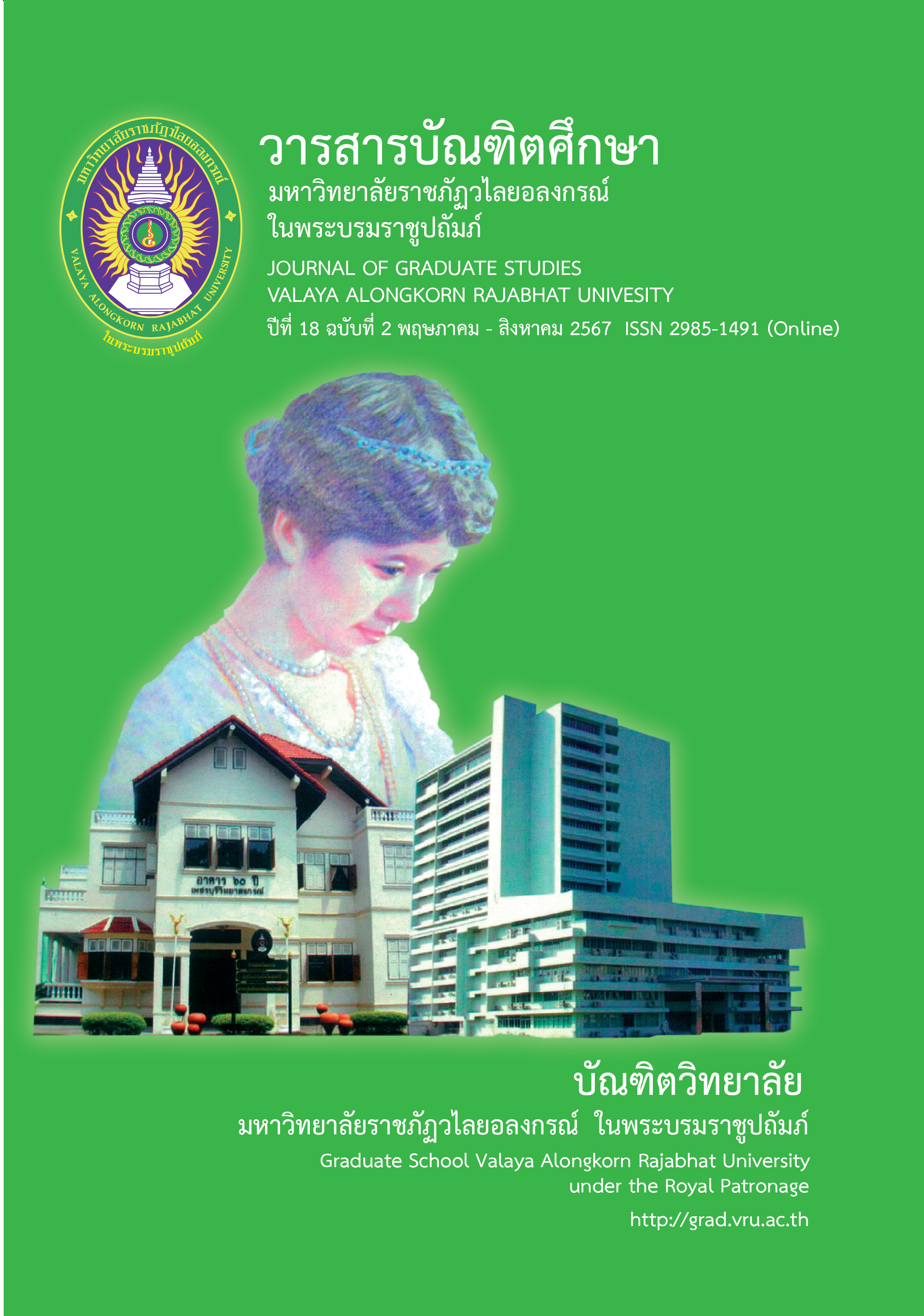TEACHERS' SELF EFFICACY IN TEACHING IN THE SCHOOL BOTANICAL GARDEN PROGRAM
Main Article Content
Abstract
The objectives of this research were 1) to explore science teachers' self-efficacy in implementing the School Botanical Gardens Program (SBGP) under Plant Genetics Conservation Project initated by HRH Princess Sirindhon (RSPG), and 2) to study their self-efficacy in teaching product design for sustainability. The participants are five science teachers who had supervised School Botanical Gardens Project and a project coordinator from a school participating in SBGP. The instruments included a four -point Likert scale questionnaire and an interview protocol. The data were analyzed by thematic analysis.
The results indicate that 1) science teachers perceived that they were confident at a high level that they could implement SBGP. It is classified into self-efficacy in various dimensions, consisting of (1) professional development for teachers and as school counselors; they thought that they could help other teachers implement SBGP and teach the students (3.56 ± 0.24). (2) This could help students engage in the school botanical garden’s activities (3.33 ± 0.25). (3) They knew and understood the curriculum and activities of SBGP well (3.00 ± 0.19). And 2) the science teachers, however, perceived that they had limited understanding and experience in (1) teaching community–based science projects, (2) engineering design processes, and (3) the application of biomimicry in product design for sustainability. It was found that they perceived that they were unable to manage the teaching and learning for sustainable design. Nevertheless, they were ready and intent to develop themselves to be able to teach accordingly. This present study had implications in designing and developing a professional development program for teaching product design for sustainability.
Article Details

This work is licensed under a Creative Commons Attribution-NonCommercial-NoDerivatives 4.0 International License.
บทความทุกเรื่องได้รับการตรวจความถูกต้องทางวิชาการโดยผู้ทรงคุณวุฒิ ทรรศนะและข้อคิดเห็นในบทความ Journal of Global of Perspectives in Humanities and Social Sciences (J-GPHSS) มิใช่เป็นทรรศนะและความคิดของผู้จัดทำจึงมิใช่ความรับผิดชอบของบัณฑิตวิทยาลัย มหาวิทยาลัยราชภัฏวไลยอลงกรณ์ ในพระบรมราชูปถัมภ์ กองบรรณาธิการไม่สงวนสิทธิ์การคัดลอก แต่ให้อ้างอิงแหล่งที่มา
References
Ashton, P. T. (Ed.). (1990). Theme: Pedagogical content knowledge [Special issue]. Journal of Teacher Education. 41(3).
Asunda, P. A. & Hill, R. B. (2007). Critical features of engineering design in technology education. Journal of Industrial Teacher Education. 44(1), 25–48. Retrieved from http://scholar.lib.vt.edu/ejournals/JITE/v44n1/pdf/asunda.pdf.
Aujirapongpan, S., Vadhanasin P., Chandrachai, A. & Cooparat, P. (2010). nawatkam: khwāmmāi praphēt læ khwāmsamkhan tō̜ ʻakān pen phūprakō̜pkān [Innovation: Definition, types and importance to entrepreneurship]. Journal of Business Administration. 33(128), 49-65.
Benyus, J. M. (2002). Biomimicry: innovation inspired by nature. New York: Perennial.
Blonder, R., Benny, A. & Jones, M. G. (2014). Teaching self-efficacy of science teachers. the role of science teachers’ beliefs in international classrooms from teacher actions to student learning. 3-16.
Cunningham, C. M. & Carlsen, W. S. (2014). Teaching engineering practices. Journal of Science Teacher Education. 25(2), 197-210.
Doppelt, Y., Mehalik, M. M., Schunn, C. D., Silk, E. & Krysinski, D. (2008). Engagement and achievements: a case study of design-based learning in a science context. Journal of Technology Education. 19(2), Spring 2008.
Guskey, T. R. & Passaro, P. O. (1994). Teacher efficacy: A study of construct dimensions. American Educational Research Journal. 31, 627 – 643.
Hughes, T. J. R. (1987). The finite element method: linear static and dynamic finite element analysis. Prentice-Hall.
Hynes, M., Portsmore, M., Dare E., Milto, E., Rogers C. & Hammer, D. (2011). Infusing engineering design into high school STEM courses. National Center for Engineering and Technology Education.
Lenau, T. A., Metze, A.-L., & Hesselberg, T. (2018). Paradigms for biologically inspired design. Proc. SPIE 10593, Bioinspiration, Biomimetics, and Bioreplication VIII (Publication no. 10.1117/12.2296560).
Moriarty, G. (1994). Engineering design: content and context. Journal of Engineering Education. 83(2), 135 – 140.
National Innovation Agency. (2006). samnakngān nawattakam hǣng chāt [Best Thai innovation]. Bangkok: National Innovation Agency (Public Organization), Ministry of Science and Technology.
Plant Genetic Conservation Project Under the Royal initiative of Her Royal Highness Princess Maha Chakri Sirindhorn. (2017). khūmư̄ kāndamnœ̄n ngān sūan phrưksasāt rōngrīan 2017 [Annually for the school botanical garden A.D. 2017]. Retrieved from http://www.rspg.or.th/botanical_school/instruction_2560/index.html
Pongsophon, P. (2018). kānthotsō̜p mō dē lō̜ samakān khrōngsāng phahu radap kānsāng čhitsamnưk nai kānʻanurak sapphayākō̜n thammachāt phāitai ngān sūan phrưksasāt rōngrīan khrōngkān ʻanurak phanthukam phư̄t ʻannư̄ang mā čhāk phrarātchadamri somdet phra thēp rattana rāt Sudā Sayām bō̜rom rāt kumārī [The validation of multilevel structural equation modeling of moral obligation to conserve natural resource under the Royal Initiative of HRH Princess Maha Chakri Sirindhorn]. Proceedings of 56th Kasetsart University Annual Conference: Education, Economics and Business Administration, Humanities and Social Sciences. Kasetsart University, Bangkok. 163-170.
Pongsophon, P. & McComas, W. F. (2018). Validating a causal model of moral obligation for plant conservation in a nationwide school botanical garden program among high school students in Thailand. Paper presented at the International Science Education Conference 2018, The National Institute of Education, Singapore.
Shahd, M. M. M., Elmokadem, A. A. E. & Elhafeez, M. M. A. (2014). Biomimicry levels as an approach to the architectural sustainability. Port Said Engineering Research Journal. 18(2), 117 -125.
Tschannen-Moran, M., Woolfolk Hoy, A. & Hoy, W. K. (1998). Teacher efficacy: Its meaning and measure. Review of Educational Research. 68, 202–248.
Woolfolk Hoy, A., Hoy, W. & Davis, H. (2009). Teachers’ self-efficacy beliefs. In K. R. W. A. Wigfield (Ed.), Handbook of motivation at school (pp. 627–654). New York: Routledge.
Zhai, J. & Dillon, J. (2014). Communicating science to students: investigating professional botanic garden educators’ Talk During Guided School Visits. Journal of Research in Science Teaching. 51(4), 407–429.


